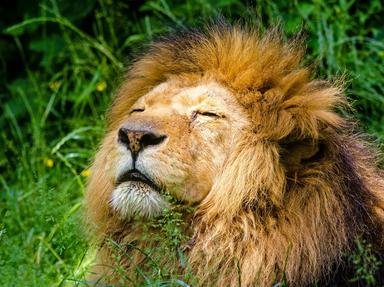Quiz Answer Key and Fun Facts
1. The leopard is the hero of 'How the Leopard Got His Spots'. While leopards do have spots on their coats, what is the actual term for the clusters of spots on a leopard's fur?
2. The giraffe is one of the world's most distinctive animals, with a long neck, a blue-black tongue and a blotchy white or cream coat. Every giraffe's coat is different. True or false?
3. The black-and-white striped zebra is a relative of the horse, being a member of the genus Equus. There are three main zebra species; which of these is not a real zebra species?
4. The eland is a species of antelope that appears in 'How the Leopard Got His Spots'. There are two subspecies of eland in the genus Taurotragus; one is the common eland, but what is the other one?
5. The kudu, or 'koodoo' as Kipling spells it, is another species of antelope that can be found in South Africa. Which of these answers best describes the markings on a kudu's coat?
6. Two other animals that Kipling mentions in 'How the Leopard Got His Spots' are the bushbuck and what Kipling refers to as the 'bonte-buck'. The Cape bushbuck is an antelope species, but is the 'bonte-buck' a real animal?
7. 'How the Leopard Got His Spots' mentions a hartebeest as one of the animals preyed on by the leopard and the Ethiopian. Which of these is an alternative name for the hartebeest?
8. When the leopard and Ethiopian are unable to hunt their usual quarry, they resort to eating beetles and what Kipling refers to as 'rock rabbits'. The rock rabbit is not an actual species of rabbit, but a small furry animal that is distantly related to manatees and elephants. What kind of animal is a rock rabbit? (Hint: it's in the Bible.)
9. The leopard and the Ethiopian are advised by Baviaan, the 'dog-headed barking baboon', to 'go into other spots' like the animals who have seemingly disappeared. Which baboon subspecies, with a long, dog-like face, can primarily be found in Southern Africa?
10. 'How the Leopard Got His Spots' mentions the quagga, a subspecies of zebra, very briefly among the leopard and the Ethiopian's prey. The quagga lived in South Africa in Rudyard Kipling's time, but can it still be found there today?
Source: Author
Kankurette
This quiz was reviewed by FunTrivia editor
rossian before going online.
Any errors found in FunTrivia content are routinely corrected through our feedback system.
